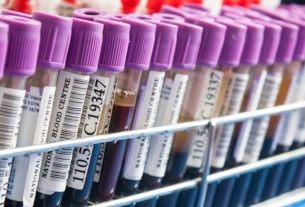Immunoglobulin E, or IgE, is a protein present in low concentrations in the blood and is normally found on the surface of some blood cells, mainly basophils and mast cells, for example.
Because it is present on the surface of basophils and mast cells, which are cells that normally appear in higher concentrations in the blood during allergic reactions, IgE is generally related to allergies, however, its concentration can also be increased in the blood due to diseases caused by parasites. and chronic diseases, such as asthma, for example.
The IgE measurement is made from the analysis of a small blood sample collected in the laboratory, and it is not necessary to fast.

What is it for
The doctor may indicate the IgE dosage in the following situations:
- Investigate frequent allergies;
- Investigate parasite infection;
- Investigate bronchopulmonary aspergillosis, which is a disease caused by a fungus and affects the respiratory system. Learn more about aspergillosis.
Despite being one of the main tests in the diagnosis of allergy, the increased concentration of IgE in this test should not be the only criterion for diagnosing allergy, and an allergy test is recommended. See what allergy testing is and how it is done.
Furthermore, this test does not provide information about the type of allergy, making it necessary to measure IgE in specific situations in order to check the concentration of this immunoglobulin against different stimuli, which is the test called specific IgE.
How the exam is carried out
To take the IgE test it is not necessary to fast, a blood sample is collected and sent to the laboratory for analysis. The result is released in at least 2 days and the concentration of immunoglobulin in the blood is indicated, as well as the normal reference value.
It is important that the result is interpreted by the doctor together with the results of other tests. The total IgE test does not provide specific information about the type of allergy, and additional tests are recommended.
Normal total IgE values
The value of immunoglobulin E varies according to the person’s age and the laboratory in which the test is carried out, and may be:
What does high IgE mean
The main cause of an increase in IgE is allergies, however there are other situations in which there may be an increase in this immunoglobulin in the blood, the main ones being:
- Allergic rhinitis;
- Atopic eczema;
- Parasitic diseases;
- Inflammatory diseases, such as Kawasaki disease, for example;
- Myeloma;
- Bronchopulmonary aspergillosis;
- Asma.
Furthermore, IgE may also be increased in the case of inflammatory bowel diseases, chronic infections and liver diseases, for example.
Hyper IgE syndrome
Hyper IgE syndrome is a type of primary immunodeficiency in which IgE levels above what is considered normal for the age can be noted, as well as increased levels of circulating eosinophils. In this type of change, it is possible to have eczema, the appearance of an abscess caused by bacteria in the skin, lungs and joints, as well as a decrease in bone mass and an increase in the frequency of fractures.
It is important that the general practitioner, rheumatologist or immunoallergologist is consulted so that it is possible to complete the diagnosis and initiate the most appropriate treatment according to the symptoms presented by the person, which may involve the use of antibiotics, antihistamines or skin creams. .
Bibliography
- IMMUNE DEFICIENCY FOUNDATION. Hyper IgE Syndrome. Disponível em: <https://primaryimmune.org/about-primary-immunodeficiencies/specific-disease-types/hyper-ige-syndrome>. Acesso em 08 jun 2021
- AROSA, Ferdinand A.; CARDOSO, Elsa M.; PACHECO, Francisco C. Fundamentals of immunology. 2nd edition. LIDEL, 2012. 203; 232-233.
- WILLIAMSON, Mary A.; SNYDER, Michael. Interpretation of laboratory tests. 9th edition. Guanabara Koogan, 2013.

Sign up for our newsletter and stay up to date with exclusive news
that can transform your routine!
Warning: Undefined array key "title" in /home/storelat/public_html/wp-content/plugins/link-whisper-premium/templates/frontend/related-posts.php on line 12
Warning: Undefined array key "title_tag" in /home/storelat/public_html/wp-content/plugins/link-whisper-premium/templates/frontend/related-posts.php on line 13



